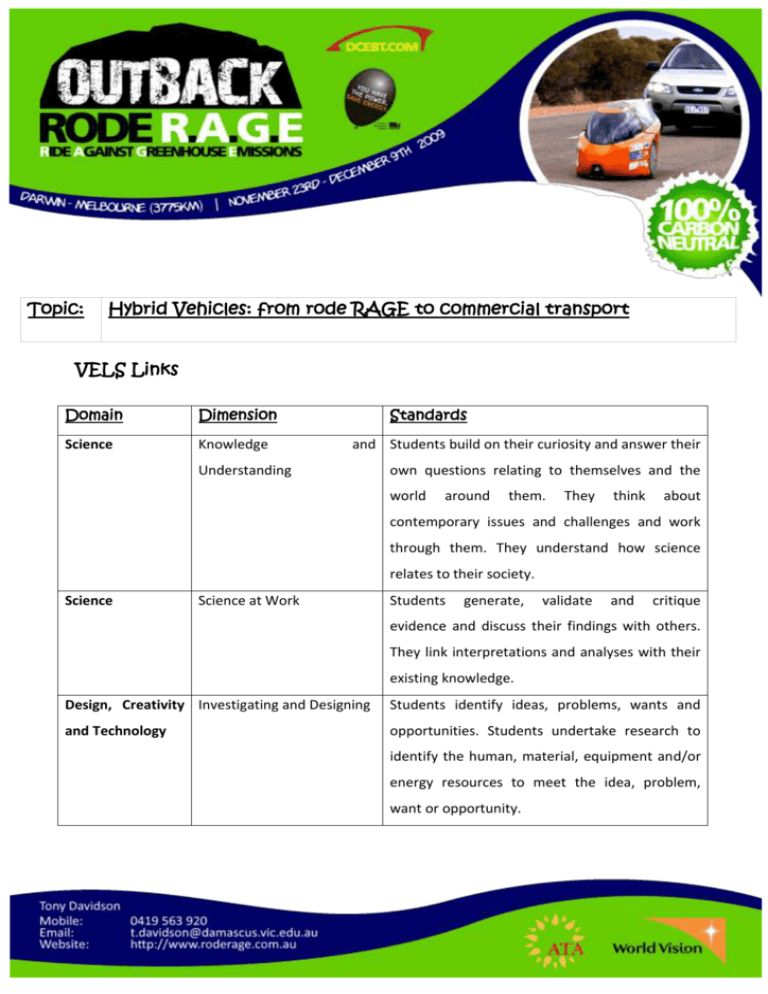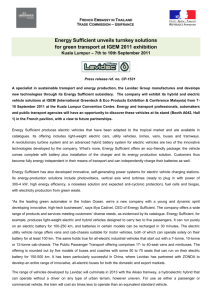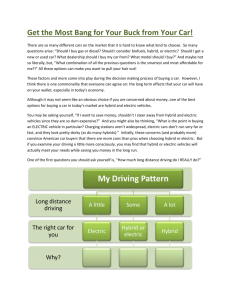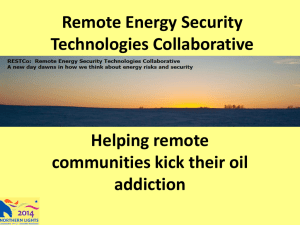Level 3 Hybrid Vehicles from Rode RAGE to commercial transport
advertisement

Topic: Hybrid Vehicles: from rode RAGE to commercial transport VELS Links Domain Dimension Science Knowledge Standards and Students build on their curiosity and answer their Understanding own questions relating to themselves and the world around them. They think about contemporary issues and challenges and work through them. They understand how science relates to their society. Science Science at Work Students generate, validate and critique evidence and discuss their findings with others. They link interpretations and analyses with their existing knowledge. Design, Creativity Investigating and Designing Students identify ideas, problems, wants and and Technology opportunities. Students undertake research to identify the human, material, equipment and/or energy resources to meet the idea, problem, want or opportunity. Design, Creativity Producing Students reflect upon their progress and alter and Technology their plans as they need to. Design, Creativity Analysing and Evaluating Students compare their previous ideas to the and Technology finished product. They reflect on their own designs and on others. Communication No dimensions at Level 3 Students listen to one another’s ideas and work together to plan and present information. Information and ICT for visualising thinking Communications Students use ICT to assist their thinking strategies and develop their understanding. Technology (ICT) English Reading, writing, speaking Planning, composing, editing and publishing a and listening. range of texts. Students using oral language to convey and receive meaning. Understanding, reflecting and critically analysing texts. Links to Rode RAGE Students will look at a wide range of environmentally friendly methods of transport including the use and environmental impact of the Rode RAGE vehicles. Students will be required to analyse the positive and negative aspects of hybrid vehicles and the effect they have on the environment. Students will also be responsible for exploring ways in which their community can become greener and environmentally friendly and find ways to encourage purchasing of hybrid vehicles. Teacher Background Information – An overview of the topic In the coming years we can expect to see the introduction of plug-in hybrid cars which are being planned by Toyota and General Motors (World Watch Institute, 2008). This will allow vehicles to run on sun and wind power and renewable bio-fuels (World Watch Institute, 2008). Consumers play a large role in moving products to become greener, for example Toyota’s hybrid vehicles sales went from 18,000 cars sold in 1998 to 312,500 in 2006, in 2008 the number of hybrid vehicles sold by Toyota was more than 1 million (World Watch Institute, 2008). Projects such as rode RAGE not only reinvent hybrid vehicles but by travelling to different areas of Australia advertise the need to lower greenhouse emissions and remind people of the importance of the environment. Commercial hybrid vehicles are becoming more popular, as shown by the information from the World Watch Institute. However some people are still interested in the bigger, more powerful cars (Agence France-Presse, 2009). Students should be encouraged to explore the positive and negative aspects of hybrid vehicles, not only so they can successfully advertise the positives, but as the future consumers they need to look at how hybrids can be sold and why they are not highly appealing to everyone at the moment (Hall, 2009). Aims and Outcomes SCIENCE OUTCOMES Students will be able to: o Identify how science relates to their society o Identify and describe contemporary issues and challenges and work through them. o Describe interpretations and analyse them with their existing knowledge o Ability to undertake research to identify the human, material, equipment and energy resources to meet their idea, problem, want or opportunity. o Ability to compare their previous ideas to the finished product. o Describe their ideas and knowledge of hybrid vehicles o Identify differences and similarities of hybrid vehicles to normal vehicles. o Graph results of survey o Discuss what scientific points they are going to raise in their own persuasive writing o Participate in group discussion LITERACY OUTCOMES Students will be able to: o Plan, compose, edit and publish a range of texts. o Use oral language to convey and receive meaning. o Understand, reflect and critically analyse texts. o Listen to other people’s ideas and opinions o Reflect on their own work as well as the work of others o Identify their progress on tasks o Ask a range of questions to their community o Form a view and opinion o Find ways to advertise and promote hybrid vehicles o Understand the layout and structure of a persuasive text o Ability to create a mural using all the information obtained throughout the unit. o Participate in group discussion Conducting the Project in the Classroom LESSON 1 – Introduction: Mind Map Inform students they will be beginning a new topic relating to the Outback Rode Rage (Ride Against Greenhouse Emissions). In this lesson children will be completing a class mind map. To begin, ask students what they already know about Hybrid vehicles/cars? Do they know the positives and negatives about them? Create a classroom mind map with all the information the children discussed on poster paper. This poster will be displayed in the room throughout the entire topic. Once the children have discussed what they already know, allow them to go to the computers to further their research. Encourage them to find as much information as they can i.e. Pros, Cons, how the vehicles help the environment and why etc. After they have researched as much as they can, get the children to come back as a class and enter the new data onto the mind map. Discuss the information as a class so that students now have a good idea of what hybrid vehicles are. After each proceeding lesson, and as students find and learn new information about this topic, allocate 10 minutes at the end of each lesson to discuss any new information found and add this to the class mind map. LESSON 2 – Toyota Website This short lesson will help build on the children knowledge of what a hybrid car is. Using the interactive whiteboard (if available), show students the website: http://www.toyota.co.jp/en/kids/eco/anime_hyb.html. This website has animations, videos and information all about hybrid cars and ways to protect the environment. The kids will love this website as it is fun and interactive. While viewing the website allow the children to make a list of any information they think is useful. Once you have finished showing the website add any new information found to the class mind map. LESSON 3 – Venn Diagram Position students on the floor so that each can clearly view the mind map from the previous lesson and revise the information the students learnt and found. Ask students if they know what a Venn diagram is. (A Venn diagram is represented by two circles which show the relationship between the two sets). Inform students that they will be completing a Venn diagram worksheet (see Worksheet 1) comparing a hybrid vehicle and a normal vehicle. On one side of the circle they will list all the features of a hybrid vehicle. On the other they will list all the features of a normal vehicle and in the middle they will list any information that is the same. Once they have entered all the information, allow students time to decorate their Venn diagrams; by using colour, draw pictures etc. Once finished go through what information was written in each circle and create a discussion in the classroom. Allow time to add any further information onto the class mind map. After it has been discussed, hand their diagrams around the room so that students can refer to the information at any time during the upcoming lessons. LESSON 4 & 5: Community Research Project Further Teacher Background Travelsmart acknowledges that almost everyone is involved in some form of transport daily. It simply wants people to be more travel conscious, e.g. car pooling, walking, riding a bike or catching public transport (Australian, State and Territory Governments, 2007). Students need to be aware of their community’s views on hybrid vehicles and what they are doing to reduce greenhouse emissions. This can influence their views and needs to be taken into account when they are completing their advertisements, letters and so on so that they understand the community’s needs, wants and opportunities. Lesson Plan Using the questionnaire worksheet (See worksheet 2) students should research the methods of transport their community uses. This could involve asking teachers, other students, parents or family friends to participate in the questionnaire or involve the class visiting a local shopping centre or supermarket during school time to fill in their sheets. Encourage students complete the sheet themselves and to ask at least 2 people each to complete their survey. In the second lesson, students share their answers; this can be graphed as a whole class either on the white board or using an interactive whiteboard with a graphing program, such as Grapher from http://www.amblesideprimary.com/ambleweb/mentalmaths/grapher.html Students should be encouraged to discuss why people are more likely to drive or walk and so on. This activity is an introduction into how they can try to change their community into becoming greener and environmentally friendly; it also allows them to recognize the need for more advertising of other methods of transport, not just always driving. LESSON 6 : Debate Now that each child has learnt what a hybrid vehicle is and knows the pros and cons of them, get them to discuss their opinion in a debate form. This activity is called ‘fold the line’. This gets children to form their own personal view on the topic. Inform students that they will need to make a decision based on this question: Would they prefer to buy a hybrid car or would they prefer to buy a normal car? Those who would prefer to but a hybrid car then lines up along one end of a line. Those people who chose a normal car then line up along the other end. The teacher now folds the line over so that each person is with someone who believes the opposite to them. Once they have been paired up, each child is then required to try and persuade their partner to change opinions. While doing this, they can use any information they have learnt in previous lessons. The aim of this activity is to get the students discussing the positives and negatives of each one and to have discussions about the topic with another person. Give students enough time to debate with each other. Once discussing seems to be coming to an end, ask if any of the students changed their opinion, and why? Or Why not? To finish off the lesson, add any new information to the mind map. LESSONS 7, 8 & 9: Advertising hybrid vehicles Further Teacher Background The article on General Motors (GM) shows that although GM is producing more environmentally friendly vehicles consumers in America are still interested in bigger, less environmentally friendly cars (Agence France-Presse, 2009). Therefore to keep up with demands GM has had to produce more vehicles which are bigger and more powerful than the hybrids (Agence France-Presse, 2009). This shows that companies are making the change, however consumers still need to be persuaded. To be effective in advertising students should be encouraged to decide their target audience(s), advertise in the right places, e.g. assembly hall where lots of foot traffic passes and establish a memorable image for consumers to identify with (AllBusiness, 2009). Lesson Plan Ask students if any of their parents or family friends own hybrid vehicles. Reflecting on their positive/negative evaluation worksheets of hybrid vehicles would they buy one? Why/why not? Talk about the General Motors article (Appendix 1), why would Americans want “gas guzzlers” instead of environmentally friendly cars? Explain to the students that they will be working in pairs to design an advertisement to sell a hybrid vehicle. The vehicle should entice consumers into buying a hybrid to lower green house emissions. In order to do this students should focus on turning the negative aspects of hybrids into positives to make the vehicles as appealing as the “gas guzzlers” mentioned in the article. This first lesson should be used to further research hybrid cars but focusing more on the marketing aspects. During this lesson, show students the video on this website which emphasis why hybrid cars are so beneficial. http://australia.betterplace.com/get- involved/?gclid=CNqbtKzWjZwCFUUwpAod9zw7Xg. This information may be useful in for their advertisement. Allow students time to draft their advertisement and poster with their pair. Encourage them to have a good understanding of what they will be writing and drawing on their poster in the next lesson. In the next lesson the students should begin their posters, encourage them to use a catchy slogan or jingle to accompany the poster. They can use computers, paint and magazine cut outs, anything they like to design an eye-catching and attractive poster. In the final lesson the students will present their posters to the class aiming to “sell” their hybrid. If possible invite students from other classes, parents or other teachers to vote for the car that entices them the most. LESSONS 10, 11 & 12: Writing a persuasive letter Further Teacher Background According to the Department of Climate Change website one of the largest challenges of our time is the environment (Commonwealth of Australia, 2008). The Government acknowledges that climate change cannot be avoided and wants Australia and the world to be prepared, it also wishes to “reduce greenhouse pollution in Australia in the short and long term” (Commonwealth of Australia, 2008). Although the website confronts many major issues on climate change, such as recycling and carbon pollution reductions, it does not go into great depth about the introduction of hybrid vehicles or promoting public transport. This is where the students should be encouraged to come up with ideas such as wider footpaths for cyclists to use, walk to school days or months, fees for people driving big cars by themselves opposed to car pooling and so on. Lesson Plan Ask students how they get to school, e.g. ride their bike, drive, walk and so on. Talk about what methods of transport would be better for the environment than others, e.g. taking the bus, because the buses will be running regardless. Try and create some class discussions, noting ideas on the board as they come up. Talk about ways in which the community could be encouraged to take more public transport, walk or ride to work and school. Who would the class have to talk to so their ideas were heard? The town mayor, prime minister, parents, the school principal, etc. Explain to students that they will be writing a letter trying to persuade a leader to make changes to the community; these changes can be anything the class has spoken about previously, for example, incentives for families who walk to school every day or wider footpaths for bicycles. The letter should include persuasive arguments as to why the issue is so important, they can include pictures the students have drawn of their ideas. Allow students to choose their own audience. In the first lesson, show students the website writing fun which discusses the structure of a persuasive text and has numerous examples of different letters which the children can view: http://www.teachers.ash.org.au/jeather/writingfun/writingfun.html. This is a really good website as it lists step by step what they children need to do in order to write their persuasive letter. Go through the website slowly highlighting any key points with the children. Once students have had enough time looking through the site, brainstorm any ideas on the board on what arguments they may want to write about. E.g. Cars are bad for the environment therefore hybrid vehicles should be used by everyone. Hand out persuasive template worksheet (See Worksheet 3 ) and allow students to fill out the sheet and write down the arguments they want to use in their letter. In the second lesson the students will begin drafting their letter. Once again show students the template of a persuasive letter from the writing fun site. Keep this site up on the board so that they can refer back to it at any time. Walk around the room to ensure all students are on track and understand the task. Give students entire lesson to draft letters. Any early finishes need to begin proof reading their letter and inform those who did not finish to complete their draft letter at home. In the third lesson, students should be encouraged to proof read their letters before letting the teacher correct them. Once corrected and proof read, allow students to type up their letter. Once they have finished students can print off their letter and put them in envelopes. If possible the teacher should organize stamps for the letters and a walk to the local post office to send the letters to their selected audience. LESSON 13: Creating a mural Brainstorm on the whiteboard topics that have been covered during the rode RAGE lessons, e.g. walking to school, pollution’s impact on the earth, hybrid vehicles, commercial vehicles and so on. Assign students into groups and allocate each group a different topic (group sizes will vary depending on the amount of topics raised). Reflecting on the topics included in rode RAGE create a mural which shows the students learning journey throughout these lessons. Colourful paints, paper, photos, etc can be used to engage the students. The mural should be a whole class effort and be displayed somewhere where parents and other students gather. If possible the class should present their mural to assembly or another classroom and talk about rode RAGE and what they have learnt about hybrid vehicles and becoming a greener community. By presenting their mural students may reinforce what they have already learnt and also introduce the topic of hybrid vehicles and sustainability to others. Further Information for Students to Research o Students can complete their own ecological footprint before starting this unit. They can do it at school or even at home with their parents as some questions can be quite difficult. http://www.epa.vic.gov.au/ecologicalfootprint/globalfootprint/index.asp o Students can look through this site which has numerous videos of different types of hybrid vehicles. These are questions which are linked to the videos. http://www.pbs.org/wgbh/nova/teachers/activities/3507_car_video.html o This website is also interesting as it talks about the future of our world in relation to vehicles and other transportation methods. http://library.thinkquest.org/04oct/01249/ Student Worksheets Attached Worksheet 1 – Venn diagram template Worksheet 2 – Community Research Project Questionnaire Worksheet 3 – Persuasive Writing Template Worksheet 4 – Hybrid Vehicle Word find. (This can be used for early finishers throughout the duration of the topic) Appendix 1 – Car buyers still want gas guzzlers article What to look out for on the Rode RAGE Webcast o Children can view the Rode RAGE website and find links to further information on hybrid vehicles and climate change. o The children can use the webcam to ask those on the RODE Rage journey numerous questions about their hybrid. o They can watch the hybrid vehicle in motion and see how the vehicle works. o Children can ask and pose questions to the team regarding the energy needs of their hybrid vehicle. This can include things like - How often do you need to charge the battery? - How is your hybrid safe? - How does the vehicle protect the environment? References Agence France-Presse, (2009). Car buyers still want gas guzzlers – GM. The Australian retrieved from http://www.theaustralian.news.com.au/story/0,25197,25893253-12377,00.html on the 12th of August, 2009. AllBusiness, (2009). Top 10 Tips for an Effective Advertising Campaign. Retrieved from http://www.allbusiness.com/marketing/advertising/3983-1.html on the 12/08/09. Australian, State and Territory Governments. (2007). Travelsmart Australia. Retrieved from http://www.travelsmart.gov.au/ on the 12th of August, 2009. Eather, J. (2006). Writing Fun. Retrieved from http://www.teachers.ash.org.au/jeather/writingfun/writingfun.html on the 15th of August, 2009. Hall, G. (2009). There are positives and negatives in more than the batteries of hybrid cars. Retrieved from Ezine Articles, http://ezinearticles.com/?There-Are-Positives-And-Negatives-In-MoreThan-The-Batteries-Of-Hybrid-Cars&id=772823 on the 16th of August, 2009. Hybrid-vehicles.org, (2005). What defines a hybrid vehicle? Retrieved from http://www.hybridvehicle.org/hybrid-vehicle-definition.html on the 19th of August, 2009. World Watch Institute (2008), State of the World: Ideas and Opportunities for Sustainable Economies 2008. United Kingdom: Earthscan. Contributions Raffaela Bourke-Finn – At the beginning of this assessment Hayley and I brainstormed different lesson ideas we could work on. We then divided the workload and researched and planned lessons. During the allocated time for the assignment to be completed we met on a regular basis and swapped ideas and lesson plans for each other to read over. I found this way of working together very helpful and efficient. Hayley and I are able to take and give constructive criticism to each other. When finalizing our assignment we assigned roles, e.g. Hayley typed up the final assessment and I worked on references and teacher backgrounds, continuously helping each other. Hayley reflected on our group work and said that I was a great team member and someone who was easy to work with. Hayley DeRozario – I believe that our contribution to this assignment was very equal and fair. Ela and I work well together and help each other out whenever we need assistance. When it came to this assignment, we first spoke about ideas we had with our topic. We brainstormed activities and then broke them up so that we had our own ones to write up. This way of working suited both of us. We met up numerous times and emailed each other regularly to discuss new ideas. Ela commented on my group work by saying that I was great to work with and was a great communicator with ideas. Hybrid Vehicles: From rode RAGE to Commercial Transport Curriculum Resource By Hayley DeRozario and Ela Bourke-Finn







